
42 minute read
Overcoming Obstacles in Water Resistant H1 Specialty Greases Using Polymers
Erik Willett, PhD Functional Products Inc. Macedonia, OH USA
Abstract
Water resistance is a critical performance aspect of grease that often becomes an obstacle in developing non-industrial greases for the H1 incidental food contact or biobased grease markets. A specialty grease formulation may perform well in many categories but fail water resistance testing by methods such as ASTM D4049 (water sprayoff) or ASTM D1264 (water washout). Improving water resistance late in the grease development process can involve extensive changes to the formulation.
For example, HX1 base stocks are highly refined, which results in greases with low cohesion and little ability to resist the ingress of water as well as poor solubility for additives needed to fix the problem. This work shows how two HX1 grease polymers may be used in combination with a diverse range of HX1 base stocks to improve the water resistance of full PAO/mPAO base oil blends at significant cost reduction.
Conversely, greases formulated from biobased oils have high cohesion, but most natural or synthetic esters are limited to low ISO viscosity grades and have affinity for water. A higher treat rate of thickener is often used, but this can hinder fluidity and have a negative effect on the economics of the grease. This paper includes examples of how biobased viscosity modifiers can be used to build base oil viscosity, reduce thickener treat rates, and greatly improve water resistance of biobased grease.
In this work, the greases were made using hydrous calcium and calcium complex thickener from pre-formed salts, but the principles discussed in this paper apply broadly to other thickener types.
Introduction
Much of the longstanding experience in the grease industry is based on petroleum oils. Production-wise, 70% of reported grease production is lithium or lithium complex grease, and 86% uses conventional mineral oil with 7%, 5%, and 1% using synthetic, semi-synthetic, or biobased oils, respectively.1 Best practices and starting points for high performance grease formulating are well established based on the structure and properties of paraffinic or naphthenic oils and bright stocks and their interactions with additive chemistries that were developed alongside greases.
Trends continue to push for reducing the use of petroleum oils in lubricants and greases for various reasons. Highly refined or synthetic base stocks offer improved oxidative and thermal stability and the potential for longer service life. Removal of organic substances containing aromatic carbon groups can greatly reduce the aquatic toxicity of greases, especially those used in environmentally sensitive applications.
Whichever the reason, formulators who wish to develop greases in the specialty areas of NSF H1 incidental food contact (which tend to include synthetic base oils such as polyalphaolefins or PAOs) or environmentally acceptable lubricants often find unique challenges that were easily solved under standard practices in petroleum oil. The body of knowledge and experience is largely focused on industrial lithium grease, while specialty grease formulators are often confronted by a constrained list of allowable raw materials plus a shortage of know-how when exploring new greases or markets.
Properties such as oxidation stability, dropping point, extreme pressure, or wear resistance can typically be adjusted with the use of a simple additive or solved by proper selection of thickener chemistry. For example, an antioxidant can be expected to perform in a wide range of base oil types. However, it can be a much greater challenge to improve water resistance, which is highly complex behavior, may involve many different test methods, and often does not have an easy answer. This work intends to provide formulators with various strategies for improving the water resistance of H1 and biobased greases where there is a limited offering of raw materials available. Fortunately, initial choices of base oil type or grease polymer can avoid water resistance problems that may appear later on when a project matures past basic testing on wear, corrosion, oxidation, etc.
Testing greases for water resistance dates back to the ASTM D4950 specification for automotive grease originally published in 1989. This specification contained water resistance testing according to ASTM D1264 (water washout) as shown in Table A. Decades later, the new NLGI High Performance Multipurpose (HPM) grease specification (described in ASTM D7594) adds ASTM D4049 water sprayoff testing with a limit of <40% for the Water Resistant (WR) subcategory.
Table A: ASTM D4049 (water sprayoff) and D1264 (water washout) requirements for NLGI grease specifications.
Hydrous calcium grease is an ancient technology, and mixtures of lime and fat were used to make the first soap-based grease as opposed to straight lard.2 While old technology, hydrous calcium thickener chemistry is low cost, acceptable for NSF H1 formulations, biobased, and biodegradable. Hydrous calcium has fair water resistance and a dropping point below 100°C, making it uncommon for today’s demanding applications.3,4 However, these qualities make hydrous calcium grease an excellent platform to demonstrate the versatility of polymers for improving water resistance, specifically water sprayoff (D4049) at 40°C, which is the focus of this paper.
If a Bronze Age technology can be improved to equal or surpass the water resistance of modern calcium sulfonate or aluminum complex greases, then perhaps there is something to learn from antiquity. Higher dropping point and stability of the grease can be achieved by replacing 20 wt% of the calcium stearate with calcium acetate and adding a third temperature stage at 180-200°C to the process (see the Methods section) to allow the stearate and acetate to melt together and form calcium stearate-acetate complex (CaStAcX) grease. Preliminary work with CaStAcX grease was conducted to prepare for future work with the higher temperature water washout test. Results were similar in performance to the calcium stearate data here.
2. Materials and Methods 2.1 Materials
Hydrous calcium and calcium complex greases were prepared from kosher CaSt and CaAc powders. The St/Ac ratio is proprietary. Table B summarizes all base oils and viscosity modifiers used to prepare base oil blends for grease at a constant ISO 150 viscosity grade. ISO 150 was chosen because it is a typical viscosity for calcium greases and to allow the use of the popular 750 SUS naphthenic oil in the preliminary work.
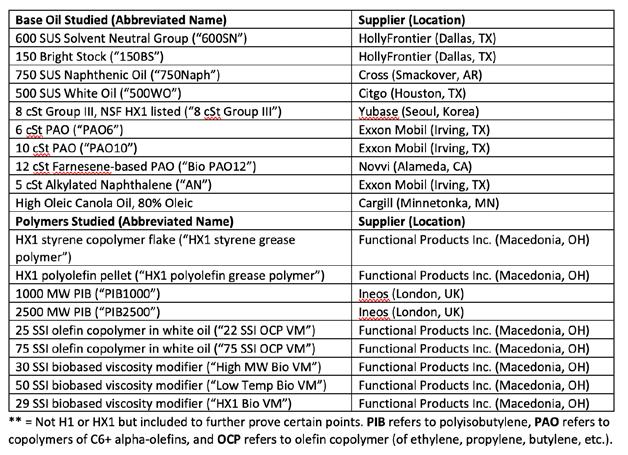
H1 CaSt greases prepared at 160°C were treated with 0.5 wt% of a powder form of NSF HX1 high molecular weight phenolic antioxidant. Biobased CaStAc complex greases prepared at 200°C were treated with 2.0 wt% of a mixture of the NSF HX1 phenolic antioxidant and a liquid aminic antioxidant in a proprietary ratio.
2.2 Equipment
500 gram batches of grease were prepared from pre-formed thickener in a three-speed Hobart C-100 mixer with a 10-quart bowl, a B-style Hobart agitator paddle, and an electronic heating mantle (Glas-Col, 600 W, 5000 mL, silicone-impregnated fiber glass, #100AO414). A 120 V Variac was used to regulate the heating mantle power and batch temperature. This equipment was operated in a closed fume hood. Production times and temperatures are described below based on type.
Greases were milled to good texture with a two-roll mill (Seattle Findings #28-281) adjusted to the finest gap setting that would allow material to pass through. The mill was modified with a motor (Dayton 6A198; 1/20 HP, 154 rpm, 20 ft-lbs torque) to power the 4:1 gear reduction. Grease was milled once then adjusted with extra base oil for consistency and grade. Adjusted grease was then milled two more times before screening through a 250 micron steel wire mesh to remove trace pieces of large particles that may interfere with sample preparation in ASTM D4049 water sprayoff. Samples were allowed to rest for 24 hours before testing.
Hydrous CaSt and CaStAcX greases were prepared at NLGI #2 grade to evaluate water resistance with added polymers. Table C summarizes the overall formulations for CaSt and CaStAcX greases with wt % thickener based on base oil viscosity arranged in Table D. Water was used to induce and stabilize the unique structure of CaSt hydrate crystals.5–7 The low dropping point of hydrated CaSt grease was considered unsuitable for any further work with ASTM D1264 water washout testing at 79°C or preparation of biobased greases due to the water content. CaStAcX grease formulations were developed as an alternative.
CaStAcX greases were made in all biobased base oil blends to prevent the hydrolysis of the high oleic vegetable oil. The higher production temperature (200°C vs. 160°C) was offset by the use of 2 wt% of a phenolic/aminic antioxidant blend. The St-Ac ratio can be adjusted to optimize various properties such as yield, dropping point, and low temperature fluidity.2,8–11 No excess calcium hydroxide or other base was added.
All thickeners, base oil, and additives were charged to the kettle (i.e., no hold-out). Minor amounts of extra base oil blend were used to correct for consistency and obtain #2 grade greases.
Table C: Hydrous calcium stearate and calcium stearate-acetate grease formulations (note: VM refers to viscosity modifier)
Table D: Typical thickener usage vs. NLGI grade for calcium greases depending on thickener and base oil (note: veg oil refers to vegetable and bio refers to biobased oils)

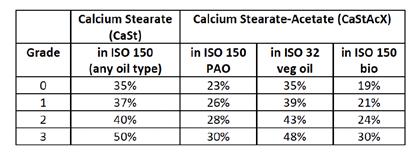
Order of operations:
1. Charge components to kettle at room temperature. 2. Set the Variac at 80°C and agitate on low speed until the target temperature is reached. • Batch will be paste- or dough-like.
3. Set the Variac at 150-160°C and agitate on medium speed until the target temperature is reached. a. Batch will take on a gelatinous, viscous quality. 4. If making CaStAc grease: set the Variac at 180-200°C and agitate on medium speed until the target temperature is reached. • Batch will take on a slightly granular texture. 5. Mix for 30 minutes if using no grease polymer or using the flake form of HX1 styrene grease polymer. Mix for 90 minutes instead if using the pellet form of HX1 polyolefin grease polymer. 6. Inspect the batch every 15 minutes for residual grease polymer on the walls of the kettle to determine when grease is ready to cool. 7. Turn off the heat, remove the mantle, and mix on high speed until the temperature of the batch drops to 40°C. • Batch will have a grainy but paste-like consistency. 8. Mill the batch once on a grease mill. 9. Check the batch consistency and adjust with more base oil blend as needed until the target consistency is reached. 10. Mill the batch two more times until smooth texture is achieved. 11. Press the grease through a 250 micron steel mesh to remove particulates. 12. Allow the grease to rest overnight.
The water added to the initial kettle charge was sufficient to produce working hydrous Ca greases despite mixing at 150°C. Store hydrous Ca greases in airtight containers, and clean the kettle immediately before it cools and residual grease has a chance to set.
2.4 Physical Testing and ASTM Methods
Cone penetration and NLGI grade were assessed by ASTM D1403 using a quarter-scale cone penetration device, and the results were converted to full scale for NLGI grading.
Water resistance was evaluated by ASTM D4049 water sprayoff testing (WSO) under the default parameters: a 40 psi stream of 38°C/100°F water for 5 minutes.
Water washout data were not collected in this study. However, the specific grease polymers used in this study have historically performed very well in previous water washout tests with WSO performance. In contrast, some grease polymers are known to perform well in WSO but contribute little or no improvement to washout.
Base oil composition as % paraffinic, % naphthenic, and % aromatic carbon types was collected based on: 1) reported ASTM D2140 carbon profiles for most petroleum oils; 2) general values reported in the literature (Group III and V oils); and 3) known or approximate molecular structures for synthetic oils such as 5 cSt alkylated naphthalene, PAO, PIB, viscosity modifiers, etc.
Results and Discussion
Why do some polymers work differently in various greases?
This work was originally inspired by and intended to answer questions surrounding a specific grease polymer used to improve the water resistance of industrial petroleum-based greases. The styrene-modified HX1 grease polymer flake described in the Materials section has long been sold for use in petroleum greases. Over the years, different formulators reported starkly different experiences with the performance
and texture of finished grease that contained this HX1 styrene polymer. In various cases, the polymer provided exceptionally good (low) WSO and water washout results, had no major effect on water resistance, or resulted in excessive texture and graininess in the finished grease.
Why would one additive be the best and worst additive for petroleum greases at different laboratories?
Based on early findings from this study, it was determined that the type of petroleum oil was critical. Customers had great experiences when they added the HX1 styrene grease polymer to greases that were predominantly based on straight paraffinic oils such as 600SN Group I, 600N Group II, or bright stock. Other customers obtained poor results when they used naphthenic oils such as 750 SUS or roughly equal mixtures of heavy paraffinic and naphthenic oils.
Figure 1 demonstrates the variation in performance of the styrene grease polymer at 1 wt% in NLGI #2 CaSt greases seen prepared using ISO 150 base oil blends of varying composition. The higher solvency naphthenic (200Naph/3500Naph) and paraffinic (600SN/150BS) base oils showed significant reductions in WSO. However, the naphthenic based grease had an unacceptable rubbery texture. The more expensive and highly refined base oils (PAO and white oil/PIB) gave a slight improvement that would not justify the cost of adding the styrene grease polymer.
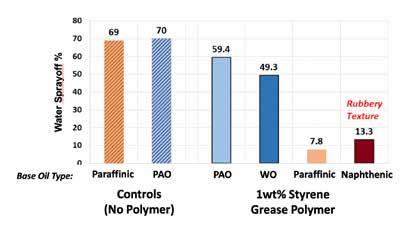
Figure 1: WSO for NLGI #2 CaSt greases using the styrene grease polymer at 1 wt% in various base oil blends (600SN = 600 SUS Group I; 150BS = 150 Bright Stock; PAO6 = PAO 6; mPAO100 = mPAO 100; 500WO = 500 SUS white oil; PIB2500 = 2500 MW polyisobutene; 750Naph = 750 SUS naphthenic oil)
Figure 1 corroborates the range of different experiences reported by formulators who used this styrene grease polymer to make different greases for different brands: excellent WSO improvement, no effect, or rubbery texture but good WSO. This explained when the HX1 styrene grease polymer performed differently but did not explain why. If the underlying reasons for the variations in performance in different base oil types could be explained, then the parameters of the base oil blends could be tuned to optimize the performance of the HX1 styrene grease polymer.
A difference in the properties or performance of any material ultimately depends on its composition and structure. Table E compares the composition of various base oils. Paraffinic oils are categorized under API Groups I, II, and III depending on basic properties such as viscosity index and percentage of saturates based on the level of refining. Several types of petroleum base oils derived from naphthenic crude oil are categorized as Group V. PAOs and some Group III (GTL) are prepared by polymerizing short runs of ethylene or CO/H2 into synthetic crudes that are then distilled as cuts.
Table E: Composition and statistics of various paraffinic and naphthenic petroleum oils. Groups IV and V data were collected from publicly available datasheets from major brands. Group I-III rangeswere obtained from Espada, Jameel, and Ray.12–14

Based on Table E, the composition of paraffinic and naphthenic oil varies mostly in the high levels of naphthenic (cycloalkane) and aromatic hydrocarbons in the naphthenic oil. This is regarded as high solvency due to the greater solvating abilities of aromatic and ring-like molecules, similar to the effectiveness of benzene, toluene, turpentines, or limonene as industrial solvents.
The key between the varying experiences formulating greases with the styrene grease polymer is then the difference in solvent quality of the base oil affecting the cohesiveness or adhesiveness of the polymer in the final grease. Figure 2 reimagines Figure 1 and the range of customer experiences along a single axis parameter referred to as qualitative base oil “solvency”.
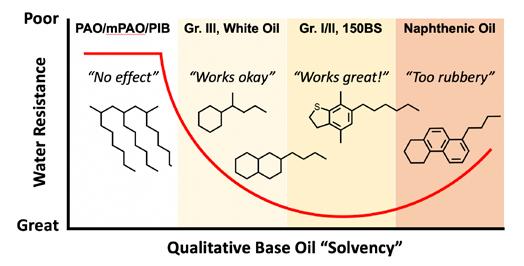
Figure 2: The range of formulators’ experiences and styrene grease polymer performance are functions of base oil composition and solvency. Too much or too little solvency produce different results. The styrene grease polymer selected for this study is sensitive to the choice of base oil, which is true for many styrene polymers.
Figure 3 demonstrates the underlying mechanism why the performance of greases formulated with styrene polymers varies with increasing base oil solvency. Styrene grease polymers have high styrene content making them insoluble in low solvency base oils at ambient temperatures – no long-range interactions or
network is formed. Medium base oil solvency allows the polyolefin midblock of the styrene copolymer to dissolve – the insoluble styrene ends associate to form a mesh-like network. Increasing the solvency further causes the styrene terminal blocks to dissolve in the oil
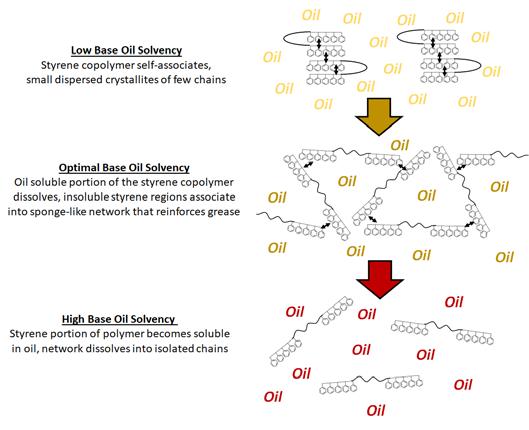
Figure 3: Mechanism for variations in observed performance of greases formulated with styrene polymer with increasing base oil solvency.
Ironically, the styrene grease polymer was found to meet NSF H1 criteria and received HX1 status although the results in Figure 2 would suggest the polymer performs best in non-HX1 oils. However it was thought that if the solvency of the petroleum or HX1 base fluids could be quantified, measured, and controlled, then it was possible to engineer one or more HX1 oil blends with similar solvency to a Group I or II paraffinic oil. It was hypothesized that the HX1 styrene grease polymer’s performance could be tuned with a mixture of HX1 base fluids similar to the examples in Figures 1 and 2.
Setting up base oil solvency calculation
Polymer solubility is complex and has been approached from many different levels of theory from “like dissolves like” to Hildebrand’s and later Hansen’s use of quantitative “solubility parameters” which must be matched closely between base oil and polymer. 15–18 Hildebrand solubility is a simple sliding scale like a ruler, while Hansen solubility is a dart board with the height and width representing hydrogen bonding and polarity. It is possible to have ‘too much’ solvency in one direction such that the solvent or polymer prefers to associate with itself and avoid forming a solution between the two different materials. Thus in Figure 2 the best performance fell within a narrow range of optimal solvency (Group I/II/bright stock), and increasing the solvency further (naphthenic oil) caused a reversal in water sprayoff performance and poor grease texture.
A system of calculating solvency and estimating WSO based on the calculated solvency was developed here for the HX1 styrene polymer in the NLGI #2 CaSt with ISO 150 base oils.
First, one looks at Figure 2 and compares the WSO performance by base oil type versus the structure of the base oils shown below in Figure 4. It is apparent that naphthenic oils have the greatest solvency arising from their excess aromatic carbon content. It is also apparent that Group III based oil blends gave noticeably better performance than pure PAO/mPAO blends. The major difference between Group III and PAO, where neither contains aromatics, is the naphthenic content. The naphthenic content of naphthenic oil vs. Group I/II paraffinic should also be considered in the first example. Although aromatic structures receive much attention for their solvency it lesser known that even non-aromatic ring structures (naphthenes) have appreciable solvency – think of limonene, a powerful non-aromatic degreaser.

Figure 4: Idealized structures of different paraffinic12,14,19 and naphthenic20 oils showing their paraffin and ring contents.
The first iteration of a mathematical model to relate the percentages of different hydrocarbons (alkanes, naphthenes, aromatics) began with plotting the % aromatic carbon of the base oil blends in Figure 1 versus the WSOs of the greases.
A quick second iteration added a term for % naphthenic carbon but applied a factor to count the naphthenic content as lower solvency than the aromatics. Roughly, WSO is a function of (% aromatic carbon in base oil blend) + (% naphthenic carbon) * N, where N < 1. Microsoft Excel was used to plot this x/y relationship using different polynomial fits and varying the coefficient N until the R2 coefficient of fit was optimized to >0.95. N was found to be 0.24 where approximately 1 wt% of aromatic carbon has the same solvency as 4 wt% of naphthenic carbon. Alkane carbon was assigned zero solvency. Molecular weight and size can affect solubility but were excluded; light or heavy oils were treated based only their carbon profile and not viscosity or molecular weight.18
Figure 5 shows the initial fit between solvency and WSO from the preliminary data points in Figure 1. This relationship can be used to engineer an HX1 base oil blend that will work better than other blends with the HX1 styrene grease polymer. The coefficients for % Aromatic C, % Naphthenic C, etc. shown in Figure 5 and the following figures are based on fitting parameters determined from the final results of this study.

Figure 5: Preliminary fit of the WSO vs. base oil solvency relationship for the HX1 styrene grease polymer. Key features are: sharp reduction in WSO with an increase in base oil solvency from oil blends #7 to #2; and WSO slightly increases when base oil solvency is greatly increased from #2 (ISO 150 Group I) to #1 (ISO 150 naphthenic). More data points are needed to improve the correlation between base oil selection and WSO.
Figure 5 is a crude fit, but it captures the sharp decline in WSO with added base oil solvency and the plateau in WSO once a certain level of WSO performance is achieved. Actually, the WSO for formulation #11 (naphthenic oil) is higher than that of #2 (Group I), and the #11 grease exhibited an undesirable rubbery texture. Both findings support the idea of “too much solvency” established in Figure 2.
HX1 base oil solvency vs. optimization of grease water resistance
A rudimentary relationship between base oil solvency and water resistance (as WSO %) has been established. The hypothesis remains that this relationship will remain true for narrowing the range of base oils to only HX1 base stocks. To investigate, this plot and dataset must be explained with more HX1 base stocks. Figure 6 compares the structures of various HX1 base stocks from petroleum and synthetic sources.

Figure 6: Common petroleum/synthetic HX1 base stocks and their structures. Certain brands of Group III paraffinic oil meet 21 CFR 178.3620(b)(1) regulations and are registered as NSF HX1.
The two sources of solvency, naphthenes and aromatics, must be found from HX1 sources that include: white oils, which are essentially dearomatized naphthenic oil (approximately 30% naphthenic carbon); HX1 Group III oils containing lesser amounts of naphthenes; and alkylated naphthalenes, which are PAOs attached to naphthalene cores and generally the only source of aromatics among the HX1 base stocks (with an estimated 45% aromatic carbon in the 5 cSt grade). Synthetic HX1 base stocks include PAO, mPAO, EPO (ethylene propylene oligomers), PIB (polyisobutylenes), and biodegradable farnesene-based PAO are all isoalkanes with no naphthenic or aromatic content for solvency.
Since aromatics have the highest influence on solvency, a 5 cSt grade of alkylated naphthalene (AN) was selected to add a controlled amount of aromatic carbon to the HX1 base oil blend. The difference in aromatic content was the largest difference in composition between the high performing Group I/bright stock blends (approximately 4-5% aromatic carbon) versus the low performing ISO 150 PAO and white oil blends (0% aromatic carbon).
The appendix contains the individual studies used to derive the Base Oil Solvency calculation. The optimization was performed by starting with % aromatic carbon + % naphthenic carbon, which were corrected by added coefficients. Naphthenic carbon was found to provide about 24% of the solvency of aromatic carbon, so a coefficient of +0.24 was multiplied by the % naphthenic carbon. Synthetic base stocks such as PAO, mPAO, and PB made negative contributions to solvency, so a -0.07 coefficient was applied. Light base oil carried over from using 5-20% of two high MW olefin copolymer viscosity modifiers (25 and 75 SSI OCP in ISO 22 white oil) was found to improve solvency, and a +0.10 coefficient was applied to the % of viscosity modifier.
The overall Base Oil Solvency equation was found to be:
Base Oil Solvency = 1.00 x [% Aromatic Carbon] + 0.24 x [% Naphthenic Carbon] – 0.07 x [% PAO + mPAO + PB] + 0.10 x [% HX1 Viscosity Modifier]
Figure 7 compiles the individual formulations (referenced by lab notebook page number) used to map out the solvency versus water sprayoff curve. A third order polynomial produced the closest fit and produced a curve similar to the predicted model in Figure 2 and the preliminary curve from in Figure 5. However, the exact relationship was better fit by a curve with the shape of a square root sign (√) due to the plateau in water sprayoff at approximately 70% from < 6 solvency and V-shaped slope from 8 – 12 solvency. A base oil solvency of 10 - 10.5 was found to be ideal for the HX1 styrene grease polymer in this study.
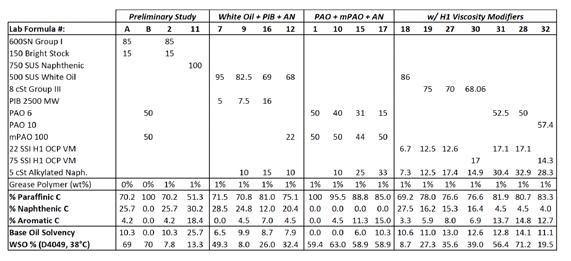
Figure 7: Top – Full table of NLGI #2 grade H1 CaSt grease formulations with 1 wt% HX1 styrene grease polymer and the resulting relationship between base oil solvency and performance of the grease polymer (i.e., water sprayoff). Bottom – Plot of water sprayoff vs. base oil solvency for the H1 CaSt greases. The general fit is a 3rd order polynomial, but the red line was added manually to show the ‘square-root’ shape of the solvency-WSO relationship. The Appendix contains individual studies that were used to determine the weighting coefficients for Base Oil Solvency.
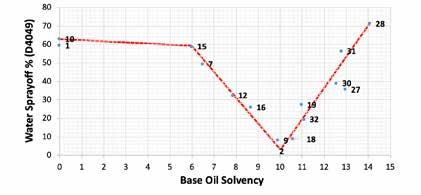
This general method can be applied to troubleshooting formulation vs. performance issues in a number of other grease applications. The goal of the work here is not to solve the problem of water resistance in CaSt for one specific polymer but to use this example as a simple framework for tackling problems in more complex grease systems. This process can be applied to solvency-based problems relating to both the compatibility of grease polymers and even grease thickeners in today’s very wide range of base oil options.
The process consists of determining which factors of base oil composition affect grease performance, quantifying base oil solvency composition as a weighted sum of those factors, and then establishing a correlation between solvency and performance. This could prove invaluable for more complicated, multistep grease thickeners like aluminum complex, calcium sulfonate complex, and polyurea.
One final note is that the solvency-WSO equation could be amended to include HX1 ester base oils such as vegetable oils, oleates/stearates, and polyols as additional sources of solvency. However, the scope of this work focused on only hydrocarbons as a simple example of this new approach, and thus, primarily white oils and alkylated naphthalenes were used. The same approach can be applied to esters, but it would be necessary to weight their different contributions to solvency by their Non-Polarity Index (i.e., the number of ester groups per molecular weight) or another measure of polarity.23
Other Polymers I – HX1 polyolefin grease polymer for PAO
A second HX1 polyolefin grease polymer with different chemistry is available to improve mechanical stability and reduce oil bleed in certain H1 greases. This polymer is known to be less polar than the HX1 styrene grease polymer, and its performance varies between base oils like that of the HX1 styrene grease polymer, although the specific responses of the two polymers are different. The HX1 polyolefin grease polymer pellet was added to grease batches in the same manner as the HX1 styrene grease polymer, but the final stage of heating was extended to 90 minutes to allow the larger pellets more time to dissolve fully into the grease.
Optimization of the HX1 base oils was performed on this second polyolefin grease polymer using the solvency-WSO parameters established with the HX1 styrene grease polymer, i.e., WSO is a function of (wt% aromatic carbon) + 0.24 * (wt% naphthenic carbon) – 0.07 * (wt% PAO or mPAO) + etc.
If the approaches developed earlier in this work could be applied successfully to a second grease polymer system, then it is most likely that it could apply to many more systems. Since the HX1 polyolefin polymer lacks styrene, one can anticipate the required solvency and solvency-WSO relationship equation would be different from that of the styrene polymer.
Figure 8 demonstrates the effectiveness of the styrene-free HX1 polyolefin grease polymer in treating low solvency HX1 base oils without the complexity of adding alkylated naphthalene. This polymer appears to be less base oil selective than the HX1 styrene grease polymer, which allows for the use of higher performance PAO and mPAO. However, 1 wt% polymer was not sufficient to produce acceptable WSOs, while 2 or 3 wt% polymer was ideal.

Figure 8: HX1 polyolefin polymer works well and reduces the WSO below the HPM-WR limit (<40%) at 2 wt% in PAO/mPAO base fluids, but performance lags in PAO/PIB. Using the highest viscosity non-metallocene PAO available (farnesene based 12 cSt PAO) to reduce the amount of PIB to replace mPAO to 20 wt% gave performance similar to that of the PAO/mPAO. There may be a critical limit to the PIB and its effect on reducing solvency in the 20-30 wt% range.
An interesting effect was noted by blending the HX1 styrene and HX1 polyolefin grease polymers at 2 wt%. The polyolefin grants high amounts of cohesion, and the styrene polymer gives high amounts of adhesion; the performance was best when both effects were both present. Figure 9 shows the effects of various ratios of the two polymers at a total usage rate of 2 wt%. This gave performance similar to that of the HX1 polyolefin polymer at 3 wt%. Thus, the mixed polymer approach would yield lower treat rate and cost to achieve very low WSO.

Figure 9: Investigating the synergy between two different types of semicrystalline HX1 grease polymers
Thermoplastics such as the HX1 styrene polymer or polyolefin are known to have synergies when mixed in applications, e.g., engineered materials or thermoplastic sealants and adhesives. This approach appears to also be valid in a grease application. These are known “polymer alloys” where two different polymers preferentially mesh to form a mixture with properties that differ from those of the two components.24 Regardless of whether this effect is used to improve a grease, this study showed that using two grease polymers can result in a unique interaction. When the HX1 styrene polymer was used by itself in the previous study, it had no effect; the combination of the HX1 styrene polymer with the HX1 polyolefin copolymer in a full PAO/mPAO grease halved the WSO value.
Other Polymers II – HX1 polar grease polymer for HX1 vegetable oil based grease
Existing work with biobased esters showed that one should use polar or hydrogen bonding polymers for treating HX1 biobased esters.25 Figure 10 compares a variety of possible polar and hydrogen bonding
functional groups that may be used to treat ester fluids. CaStAcX grease was prepared for biobased grease production to avoid the inclusion of water at high temperature that could risk hydrolysis of the vegetable oil base fluid.
Figure 10: Structural features of ester-soluble polymers and viscosity modifiers (left) versus vegetable oil (right).25 Electron density from C=C or C=O double bonds plus heteroatoms like N or O attached to C induce polarity.

The primary concern with vegetable oil based greases is the abnormally low base oil viscosities, ISO 32–36, compared to traditional petroleum grease made using ISO 100–460 or higher. The low base oil viscosity can be corrected by adding high MW polymer viscosity modifiers or low-medium MW polymeric base oils.
An NLGI #2 CaStAcX grease was produced in ISO 32 vegetable oil without the addition of polymers. The WSO was approximately 96%. Since the very low base oil viscosity was the most significant difference from prior grease formulations, the base oil viscosity was increased using several commercial biobased viscosity modifiers.
CaStAc grease was made using an ISO 150 blend of high oleic canola oil and one of three biobased viscosity modifiers to observe the effects of higher base oil viscosity: • 50 SSI biobased viscosity modifier with slight tackiness, referred to as High MW VM; • 30 SSI biobased viscosity modifier with excellent cold temperature fluidity, referred to as Low Temperature VM; and • 29 SSI biobased viscosity modifier with NSF HX1 registration, referred to as HX1 Bio VM.
Table F: Comparison of different biobased CaStAc greases prepared with ISO 150 base oil blends vs. a straight ISO 32 vegetable oil

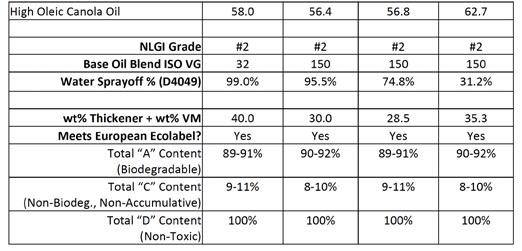
All four formulations meet the European Ecolabel standard for biodegradability and aquatic toxicity of environmentally acceptable grease. Up to 15 wt% “C”-rated content (non-biodegradable but nonbioaccumulative) is allowed in Ecolabel greases. Both the CaX thickener and active polymers in the biobased VMs contain some “C” content, but the cumulative sum is well within the limits. These starting point formulations leave room for roughly 5 wt% more “C” content that may be taken up by extra performance additives like AW/EP and corrosion inhibitors.
Three polymer chemistries all produced different results. Increasing the base oil viscosity had a dramatic effect on the efficiency of the CaX thickener and lowered the thickener usage by 25–45%. In all three cases, the biobased viscosity modifiers replaced more than their wt % of CaX thickener (i.e., the total content of thickener plus VM was lower than the control).
The high molecular weight biobased VM produced negligible improvement in WSO. While the consistency was #2 according to the cone penetration test (ASTM D1403), the grease behaved similar to a fluid (or ‘thin’) when a sample was manipulated or loaded onto the WSO jig. It appears this polymer chemistry may be non-Newtonian as it provides high consistency under sudden impacts (yielding a #2 grade under in the impact of the cone) but is very soft or flows while resting on the plate in the WSO instrument. This rheological phenomenon implies a dilatant material.
The low temperature biobased VM was most economical in that the usage of both the thickener and biobased VM were lowest. WSO was slightly improved to 75%, and the consistencies of the grade in cone penetration testing and at rest were more consistent.
The HX1 biobased VM was most effective in lowering WSO to 35.3% and within HPM-WR performance requirements. This chemistry resulted in a tougher grease than all other biobased greases prepared in this study. Comparing the molecular weight, inherent toughness of the polymers, and the amount of polymer delivered between the three different biobased VMs showed that the toughness of the pure polymer and % polymer delivered were the key factors. The HX1 biobased VM was most effective in those two categories.
A second study to achieve very low (< 20%) WSO with ISO 150 base oils and CaX thickener was not successful. Instead, increasing the base oil viscosity to very high levels was effective. A #3 CaX grease with vegetable oil was cut back to a #2 grade with 35–40 wt% biobased VM. The results were referred to as high MW VM: 35% WSO at ISO 1500 base oil viscosity; low temp VM: 12% WSO at ISO 3200 base oil viscosity; and HX1 bio VM: 8% WSO at ISO 12000. This follows the same trend in VM chemistry vs. WSO performance as the ISO 150 biobased study above. Ultimately, using very high viscosities to control water resistance is probably not feasible due to the potential impact on low temperature fluidity. This small high viscosity study showed diminishing returns on ISO VG vs. WSO after ISO 2200.
Further work was performed to achieve very low WSO with CaX at a reasonable ISO 150–460 viscosity range including modifications to the St-Ac ratio, inclusion of calcium sulfonate as a pseudo-calcium sulfonate complex, and more. 35% WSO using the HX1 biobased VM appeared to be the lower limit for CaX in vegetable oil. The high polarity and hydrophilic nature of both CaStAc and vegetable oil appeared to be major obstacles.
A graphical summary of the three studies
Overall, the approach to selecting HX1 grease polymers for water resistant H1 greases follows an axis similar to the sliding scale, ruler-like Hildebrand solubility parameter theory. Figure 11 summarizes the
spectrum of base oil solvency and types in the HX1 or biobased specialty markets and the optimal type of polymer to choose when trying to improve water resistance for specifications such as the new HPM-WR and D4049 WSO test method. These matches are presented along one axis in a Hildebrand-style sliding scale of polymer compatibility with different base fluids.
Figure 11: Structural similarities between available HX1 base fluids and HX1 grease polymers that are suitable to reduce WSO based on the findings of this study. This plot holds true for non-HX1 materials but would be greatly expanded and made more complex by the inclusion of industrial options.
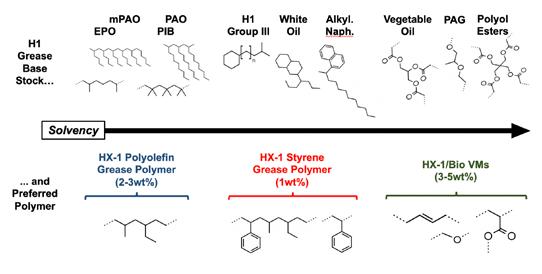
Conclusions
Grease formulation is a complicated process, especially when a project falls outside of the established knowledge that was predominantly based on petroleum oils. Certain performance aspects can be changed easily with the addition of less than a few percent of an antioxidant or a corrosion inhibitor. However, when the water resistance of a grease is deficient, addressing this issue can involve complete reformulation, which can be problematic in the late stages of a project when this problem tends to arise. This work is intended to extend the knowledge base of how to incorporate water-resistant grease polymers at the initial stage of formulating greases for NSF H1 or biobased applications.
It may be unrealistic for formulators to choose base oils in order to make 0.5–3 wt% of an HX1 grease polymers perform correctly in their incidental food contact greases. However, the number of overall polymer chemistries suitable for NSF H1 applications is small, and the number of actual suppliers producing those grades of polymer to NSF/FDA tolerances is smaller still.
The next steps of this work are to take the opposite approach and design polymers to suit specific base oils using the relationships developed in this paper. Almost a dozen structurally different NSF HX1 polymers have now been made available to investigate and treat water resistance for a wide range of greases.
Another area to investigate is sources of solvency other than alkylated naphthalenes for NSF H1 formulations. Many natural and synthetic esters are strong polar solvents and routinely used to improve the solvency of PAO gear oils to enable high teat rates of additives. This H1 grease study was limited to hydrocarbons to establish the groundwork for this approach without involving the complexity of different kinds of solvency associated with polarity and hydrogen bonding from esters.
Figure 12 begins to include formulations using white oil + AN or PAO + AN as higher solvency HX1 base fluid blends to properly dissolve the HX- styrene grease polymer according the hypothesized solvency-WSO response curve established in Figure 2. White oil and AN blends worked well to correct the deficiencies in HX1 base stock solvency and improve WSO. However PAO and AN, specifically with high amounts of mPAO, did not perform as expected in the solvency-WSO model. Base oil blends containing mPAO performed as if lower solvency. Another correction to the solvencyWSO model equation was added with a negative coefficient for the wt% mPAO. After retesting the fit, the remaining low viscosity PAO also appeared to reduce overall base oil solvency. The negative coefficient was extended to both the low viscosity PAO and mPAO. WSO is a function of (wt% aromatic carbon) + 0.24 * (wt% naphthenic carbon) –0.07 * (wt% PAO or mPAO); if the calculated base oil solvency is less than zero then it becomes zero. In effect, adding 14% PAO or mPAO removes the equivalent of 1 wt% aromatics in solvency. This is interesting as the choice to use PAO or mPAO are actively resulting in a net loss of solvency versus petroleum and white oils.
Figure 13 recalculates the Base Oil Solvency based on these observations and replots WSO vs. solvency with an added correction factor for the reduction in solvency when using mPAO or PIB (synthetic polyolefin oligomer base stocks).

Figure 12: Expanded WSO-solvency relationship including alkylated naphthalene as a source of HX1 aromatic carbon. Correlation with white oil based formulas was good but the inclusion of later PAO based formulas skewed the relationship. Some effect of the synthetic base oils has not been factored into the WSO-solvency equation. Data point #11 has been removed as an outlier due to the odd texture of the grease and it’s being the only naphthenic formula.
Figure 13: Corrected version of Figure 12 by adding a -0.07 * (wt% PAO + wt% mPAO + wt% PIB) correction factor. Data point #17 was a gross outlier likely due to the very high amount of alkylated naphthalene used to counteract the insolvency of mPAO 100. The span between data points #1 / #10 and #15 should be treated as a plateau of 60% WSO until a base oil solvency of at least 6.5 is exceeded.

By limiting or eliminating the usage of mPAO (ISO 1000+) it became difficult to formulate the HX1 base oil blends to ISO 150. 500 SUS white oil with 5 cSt alkylated naphthalene (ISO 32) requires a thickener to meet ISO 150. If using HX1 Group III oil then the problem becomes worse, as Group III is only available up to the ISO 46 “8 cSt” grade.
HX1 polyisobutylenes (“PIB”) were sourced as an mPAO replacement. After fixing several new formulations with Group III + PIB + AN, it was found that PIB causes faster loss of solvency than PAOs. WSO is a function of (wt% aromatic carbon) + 0.24 * (wt% naphthenic carbon) – 0.07 * (wt% PAO or mPAO) – 0.084 * (wt% PIB). However, PIBs are ISO 5000 to 100,000+ and can increase the base oil viscosity at lower wt% than the PAO. This results in PIBs producing a higher solvency ISO 150 than mPAO due to the lower wt% PIB than mPAO although the penalty to solvency per wt% is higher on PIB.
If using high amounts of polymer (mPAO and PIB) to increase viscosity reduces base oil solvency and WSO performance then a traditional viscosity modifier or viscosity index improver may be more effective. VI improvers are typically 5-10 wt% of a high molecular weight polymer (10K-300K Mw) in light oil.21,22 Often less than a percent of active polymer is in the final product. This would greatly reduce the usage of polymer in the base oil as seen with replacing mPAO with PIB.
Two concentrated commercial HX1 viscosity modifiers of greatly different shear stability (SSI by ASTM D6278) and MW were used to replace PIB in preparing HX1 ISO 150 base oils in white oil or Group III plus the 5 cSt alkylated naphthalene: • 22 SSI olefin copolymer in white oil (3000 cSt @ 100°C) – “Low MW OCP VM” • 75 SSI olefin copolymer in white oil (3000 cSt @ 100°C) – “High MW OCP VM”
Figure 14 demonstrates the new fit using the rules set for aromatic, naphthenic, and PAO/mPAO/PB content after including the OCP VM as a means of minimizing the content of high viscosity synthetic base stocks like the mPAO and PB. The fit becomes closer than Figures 12 and 13 but around Base Oil Solvency 10 there are some poor fits to the data.

Figure 14: Initial fit of the VM modified base oil blends in an attempt to keep the use of PIB and mPAO low but still achieve ISO 150 oil blends.
A variety of formulations in 500 white oil, 8 cSt Group III, and PAO 6 were prepared at ISO 150 using 22 SSI and 75 SSI liquid OCP VMs. Formulations were built using the establish base oil solvency calculation results established so far and to achieve an optimal 9-10 solvency rating for a target WSO of <20%. Formulations which should have been rated around 10 base oil solvency did not perform as expected. It was apparent than the OCP VMs required their own factor.
Initially, it was thought that the addition of viscosity modifier (VM) was further reducing solvency since calculated solvency was not correlating well with the addition of OCP VM in early models. More AN was added to compensate which further worsened WSO performance. Above 30% AN caused high WSO which was observed previously in the data point #17 outlier. This also supports the earlier hypothesis that the increase in WSO and unpleasant rubberiness in the full naphthenic oil formulation was due to too much solvency in the base oil. However, too much solvency in these later cases with high treat of OCP VM resulted only in higher WSO and not poor texture.
Rather than applying a solvency penalty, the data was best fit by adding a positive contribution to solvency with wt% OCP VM. WSO is a function of (wt% Aromatic C) + 0.24 x (wt% Naphthenic Carbon) – 0.070 x (wt% PAO + mPAO + PIB) + 0.10 (wt% VM). Figure 10 shows the new solvency-WSO equation and fit using this new factor.
This positive contribution of solvency and addition of too much solvency is most likely due to the light mineral oil (ISO ~22) in the viscosity modifier. Most commercial viscosity modifiers are a few percent of very high MW polymer (30K – 200K Mw) in a light ISO 20-25 oil. While all base oil blends were formulation to a constant ISO 150 the oil blends with added OCP VM at 5-20wt% will contribute very light base oil which has a greater capacity for solvency than higher MW heavy base stocks. The fitting in Figure 10 (using the final coefficients in Table G) and prior plots was based on a 3rd order polynomial regression. Looking closely at Figure 10 is apparent that the funnel shape from base oil solvency 6 to 14 is more of a sharp V or cone shape rather than a gentle curve. The response between WSO and base oil solvency is flat from 0 to 6 base oil solvency. This gives an overall shape like a square root sign (√) to the relationship between too little solvency, optimal solvency, and too much solvency vs. WSO performance of the HX1 styrene grease polymer.
Table G: Summary of contributions to solvency in the base oil solvency-WSO relationship established for the HX1 styrene grease polymer at 1 wt% in ISO 150 NLGI #2 calcium stearate grease. Multiply each row by its coefficient and take the sum for the calculated base oil solvency. Some blends (100% PAO) will result in negative solvency.
References

1. Chuck Coe. NLGI 2020 Grease Production Survey. (2020). 2. Dresel, W. and Heckler, R.-P. Lubricating Greases. Lubricants and Lubrication 648–693 (2006) doi:https://doi.org/10.1002/9783527610341.ch16. 3. Coe, C. Shouldn’t grease upper operating temperature claims have a technical basis? NLGI Spokesman 72, 20 (2009). 4. Vámos, E. and Neumann, E. Synthetic lubricating greases for the food industry. Journal of Synthetic Lubrication 1, 268–279 (1985). 5. Lelann, P. and Bérar, J.-F. Synchrotron high resolution powder study of molecular packing in hydrate calcium stearate. Materials Research Bulletin 28, 329–336 (1993). 6. Vold, R. D., Grandline, J. D. and Vold, M. J. Polymorphic transformations of calcium stearate and calcium stearate monohydrate. Journal of Colloid Science 3, 339–361 (1948).
7. Engineers, N. B. C. Lubricating Oils, Greases and Petroleum Products Manufacturing Handbook: Lubricating Oil and Grease Manufacturing, Production of Lubricants, Lube Oil Processing, Lubricating Oil Blending Plant and Production, How Lubricating Oil is made? Lubricants Manufa. (NIIR PROJECT CONSULTANCY SERVICES, 2018). 8. US Army Corps of Engineers. “Lubricants and Hydraulic Fluids”, USACE document EM 1110-2-1424. February, (1999). 9. Watanabe, K. and Tanaka, K. Study into Structural Impact of Novel Calcium Complex Grease Delivering High Temperature Performance. Tribology Online 11, 639–645 (2016). 10. Neumann, E. and Vámos, E. EFFECT OF HEAVY METAL SOAPS ON THE PROPERTIES OF CaCOMPLEX GREASES. Periodica Polytechnica Chemical Engineering 19, 75–89 (1975). 11. Panzer, J. Nature of Calcium Acetate. Journal of Chemical & Engineering Data 7, 140–142 (1962). 12. Espada, J. J., Coto, B. and Peña, J. L. Compositional and Structural Analysis of Lubricating Oil Feedstock Obtained from a Light Crude Oil. Energy & Fuels 23, 888–893 (2009). 13. Abdul Jameel, A. G. and Sarathy, S. M. Lube Products: Molecular Characterization of Base Oils. Encyclopedia of Analytical Chemistry 1–14 (2018) doi:https://doi.org/10.1002/9780470027318.a1824.pub2. 14. Ray, S. S., Pandey, N. K. and Chatterjee, A. K. Effect of aromatics and iso-alkanes on the pour point of different types of lube oils. Fuel 88, 1629–1633 (2009). 15. Storer, F. H. First outlines of a dictionary of solubilities of chemical substances. (1864). 16. Hildebrand, J. H. A critique of the theory of solubility of non-electrolytes. Chemical reviews 44, 37–45 (1949). 17. Hansen, C. M. The three dimensional solubility parameter. Danish Technical: Copenhagen 14 (1967). 18. Hansen, C. M. Hansen Solubility Parameters: A User’s Handbook, Second Edition. (CRC Press, 2007). 19. Pillon, L. Z. USE OF DSC TO STUDY THE FLOW PROPERTIES OF HYDROCRACKED BASE STOCKS AND LUBRICATING OILS. Petroleum Science and Technology 20, 101–111 (2002). 20. Sokolova, I. M., Abryutina, N. N., Punanov, V. G. and Petrov, Al. A. Chemical classification of naphthenic condensates and oils. Organic Geochemistry 19, 1–11 (1992). 21. Covitch, M. J. and Trickett, K. J. How Polymers Behave as Viscosity Index Improvers in Lubricating Oils. Advances in Chemical Engineering and Science 5, 134–151 (2015). 22. Ramasamy, U. S., Lichter, S. and Martini, A. Effect of Molecular-Scale Features on the Polymer Coil Size of Model Viscosity Index Improvers. Tribology Letters 62, 23 (2016). 23. Esters, S. B. S. E.-. Esters. in Synthetics, Mineral Oils, and Bio-Based Lubricants (CRC Press, 2020). doi:10.1201/9781315158150-3. 24. Nadkarni, V. M. Polymer alloys: science and practice. in Proceedings of the Indian Academy of Sciences-Chemical Sciences vol. 92 623–637 (Springer, 1983). 25. Wang, S. and DeVore, D. A study of polymer additives in mineral oil and vegetable oil-based greases. ELGI 2011 (2011).




